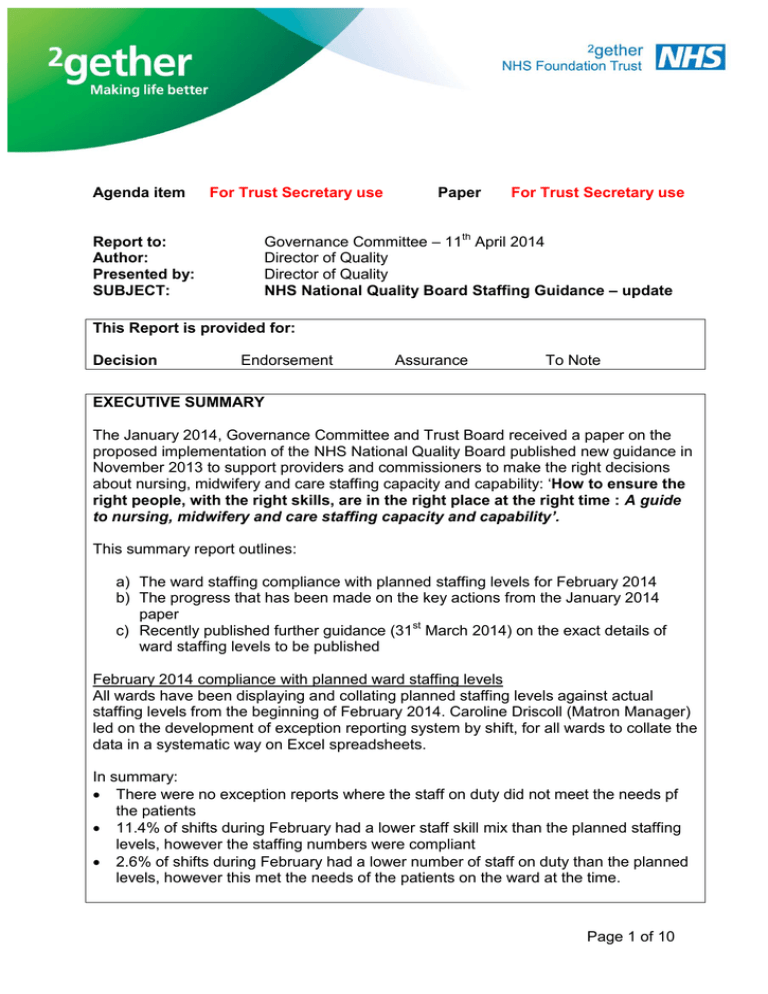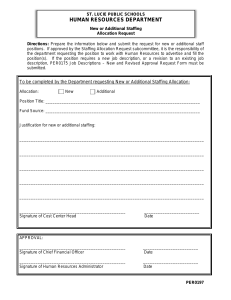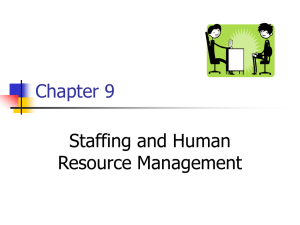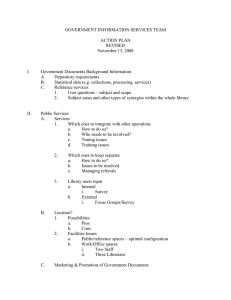– 11 Governance Committee April 2014
advertisement

Agenda item Report to: Author: Presented by: SUBJECT: For Trust Secretary use Paper For Trust Secretary use Governance Committee – 11th April 2014 Director of Quality Director of Quality NHS National Quality Board Staffing Guidance – update This Report is provided for: Decision Endorsement Assurance To Note EXECUTIVE SUMMARY The January 2014, Governance Committee and Trust Board received a paper on the proposed implementation of the NHS National Quality Board published new guidance in November 2013 to support providers and commissioners to make the right decisions about nursing, midwifery and care staffing capacity and capability: ‘How to ensure the right people, with the right skills, are in the right place at the right time : A guide to nursing, midwifery and care staffing capacity and capability’. This summary report outlines: a) The ward staffing compliance with planned staffing levels for February 2014 b) The progress that has been made on the key actions from the January 2014 paper c) Recently published further guidance (31st March 2014) on the exact details of ward staffing levels to be published February 2014 compliance with planned ward staffing levels All wards have been displaying and collating planned staffing levels against actual staffing levels from the beginning of February 2014. Caroline Driscoll (Matron Manager) led on the development of exception reporting system by shift, for all wards to collate the data in a systematic way on Excel spreadsheets. In summary: There were no exception reports where the staff on duty did not meet the needs pf the patients 11.4% of shifts during February had a lower staff skill mix than the planned staffing levels, however the staffing numbers were compliant 2.6% of shifts during February had a lower number of staff on duty than the planned levels, however this met the needs of the patients on the ward at the time. Page 1 of 10 Key actions from the January 2014 implementation actions The immediate actions have been completed and staffing information is being displayed and collated for reporting. Other actions are progressing or have been waiting for national guidance. Further guidance on publishing staffing information National guidance was published on 31st March 2014 regarding the publication of staffing information. This has been reviewed and the paper outlines in detail the requirements and work completed to date. Further work is required on the following areas: Standardised posters on describing the roles of members of the team Setting up under the Quality page on the website – ward staffing pages (due to be completed by the end of May 14) Staffing information to be published on NHS Choices will be completed by June 14 Further consideration should be given to the use of e rostering that will enable collection of data in a less time consuming It is stated that the National Quality Board will set the ground rules for publication of this data, which will form part of an integrated safety dataset that will be published on a single hospital safety website, covering the key aspects of safe care and in a form accessible to patients and the public (DH Hard Truths January 2014 Vol 1 para 1.83). As yet it would appear this has not been published, although the Director of Quality has asked the question to the Department of Health. In the interim we will continue to publish the data using the methodology already in place. RECOMMENDATIONS The Governance is asked to : Note the compliance with planned staffing levels for February 2014 Agree the publication of this information on the Trust website Note the further work required to implement the standardised requirements for publishing staffing information by ward by June 2014. Page 2 of 10 Corporate Considerations Quality implications: Resource implications: Equalities implications: Risk implications: The quality of patient care is directly linked to staffing capacity and capability. Investment in in-patient staffing of £1m occurred in Gloucestershire in-patient units in 2013/14. Herefordshire in-patient unit staffing is reviewed in line with planned contractual bed reductions. Equality implications and responding to specific patient need are reflected in the agreed staffing levels There is a risk to the quality and safety of patient care if staffing levels fall below the agreed staffing levels, or are not flexibly increased if the patient need increases. WHICH TRUST STRATEGIC OBJECTIVE(S) DOES THIS PAPER PROGRESS OR CHALLENGE? Continuously Improving Quality P Increasing Engagement Ensuring Sustainability P WHICH TRUST VALUE(S) DOES THIS PAPER PROGRESS OR CHALLENGE? Seeing from a service user perspective P Excelling and improving P Inclusive open and honest P Responsive Can do Valuing and respectful Efficient Reviewed by: Trish Jay Director of Quality Date Where in the Trust has this been discussed before? The published guidance was discussed at the Date Nursing Professional Advisory Committee Executive Committee Governance Committee Board Governance Committee update What consultation has there been? Matrons have been involved in the agreement of minimum staffing levels in their areas during 2013 Date 2.4.14 5th December 2013 December 2013 January 2014 January 2014 March 2014 December 2013 Matrons were consulted on how the format of presenting the staffing levels on their wards Feedback from Charlton Lane Matron on staffing February 2014 Explanation of acronyms used: Page 3 of 10 1. CONTEXT 1.1 The National Quality Board, sponsored by Jane Cummings, Chief Nursing Officer in England, on 19th November 2013 published new guidance to support providers and commissioners to make the right decisions about nursing, midwifery and care staffing capacity and capability: ‘How to ensure the right people, with the right skills, are in the right place at the right time : A guide to nursing, midwifery and care staffing capacity and capability’. 1.2 In January 2014, the Governance Committee and Trust Board received a paper on the proposed implementation of this guidance and compliance against the nine key expectations for providers organisation which are : 1. Boards take full responsibility for the quality of care provided 2. Processes to be in place to enable staffing establishments to be met on a shift by shift basis 3. Evidence based tools to be used 4. Clinical and managerial leaders foster a culture of professionalism and responsiveness where staff feel able to raise concerns 5. Multi-professional approach is taken when setting staffing establishments 6. Sufficient time to undertake caring duties in practice 7. Boards receive monthly updates on workforce information, and staffing capacity and capability is discussed in public Board meetings at least every six months 8. Clearly display information about the nursing and care staff present on each ward, clinical setting or service on each shift 9. Providers to take an active role in securing staff in line with their workforce requirements 10. Commissioners to seek assurance from providers about their staffing. There were a number of specific actions agreed and progressed which are outlined in this paper. 1.3 On 31st March 2014, further guidance was produced on the implementation of publishing staff information and this paper outlines in detail these requirements. 2. WARD STAFFING COMPLIANCE WITH PLANNED STAFFING LEVELS 2.1 All wards have been displaying and collating planned staffing levels against actual staffing levels from the beginning of February 2014. 2.2 Caroline Driscoll (Matron Manager) led on the development of exception reporting system by shift, for all wards to collate the data in a systematic way on Excel spreadsheets. There were five exception reporting categories developed and these are outlined below – if there is no exception then the shift was complaint with the planned staffing levels. Page 4 of 10 Code 1 Exception explanation Minimum staff numbers met – skill mix non-compliant but met needs of patients Minimum staff numbers not complaint but met needs of patients e.g. low bed occupancy , patients on leave Minimum staff numbers met – skill mix non-compliant and did not meet needs of patients Minimum staff numbers not compliant did not meet needs of patients Other 2 3 4 5 2.3 Exception reporting on staffing levels not meeting the planned staffing levels During February 2014, there were 1,428 shifts (Herefordshire units work 12 hour shifts this table assume day time shift equates to 2 shifts). Bed number Number of fully compliant shifts in the month Exception Code 1 Exception Code 2 Exception Code 3 Exception Code 4 Exception Code 5 Minimum staffing numbers MET – skill mix non compliant Minimum staff numbers NOT MET,not complaint but met needs of patients Minimum staff numbers met – skill mix noncompliant and did not meet needs of patients Minimum staff numbers not compliant did not meet needs of patients Other Ward Gloucestershire Dean 14 84/84 0 0 0 0 0 Abbey 18 84/84 0 0 0 0 0 Priory 22 51/84 32 1 0 0 0 Kingsholm 15 84/84 0 0 0 0 0 Montpellier 12 84/84 0 0 0 0 0 Greyfriars 10 68/84 15 1 0 0 0 Willow 16 81/84 0 3 0 0 0 Chestnut 14 62/84 0 24 0 0 0 Mulberry 18 82/84 2 0 0 0 0 Laurel 12 6784 17 0 0 0 0 Honeybourne 10 64/84 20 0 0 0 0 Westridge 8 59/84 25 0 0 0 0 Hollybrook 8 58/84 25 1 Herefordshire 0 0 0 Moritimer 21 82/84 2 0 0 0 0 8 82/84 2 0 0 0 0 Cantilupe 10 53/84 24 7 0 0 0 Oak House 10 84/84 0 0 0 0 0 1229/ 1428 164 37 0 0 0 Jenny Lind Total Page 5 of 10 In summary: There were no exception reports where the staff on duty did not meet the needs of the patients 86% of the shifts exactly complied with the planned staffing levels. 11.4% of shifts during February had a lower staff skill mix than the planned staffing levels, however the staffing numbers were compliant. This was a reduction in qualified staff by 1 per shift with an increase of health care assistants. 2.6% of shifts during February had a lower number of staff on duty than the planned levels, however this met the needs of the patients on the ward at the time. 3. KEY ACTIONS FROM THE JANUARY 2014 IMPLEMENTATION ACTIONS 3.1 The following table provides an update on the agreed actions: Action 1. COMPLETED Implementing a system for the collection and collation of actual staffing against planned staffing which can be reported on a shift by shift basis. This would then be reported to the Board monthly as part of the Performance Dashboard. Lead Dir of Service Delivery Timescale for implementation September 2014 The wards have been displaying the planned and actual staffing levels at the entrance to all wards since the beginning of February 2014. 2. In progress Escalation policy to be developed that documents a process for ward/team staff to escalate staffing issues and shortfalls. Dir of Service Delivery April 2014 Dir of Quality Determined by the national timescales Staff are clear how to escalate concerns reading staffing – this is being documented in to a policy document 3. In progress Staffing to reflect a nationally agreed evidence based model for mental health and learning disability clinical areas The current planned staffing levels for each ward were calculated using a West Midlands staffing calculator and professional judgement applied. These were shared in the public Board meeting in January 2014. Page 6 of 10 The Trust is contributing actively to the development of evidence based model of staffing for mental health and learning disability in-patient services. 4. In progress – but stopped due to national guidance on 31.3.14 Performance dashboard workforce metrics are reviewed to include staffing capacity metrics Dir of OD April 2014 Dir of Quality February 2014 Dir of Quality September 2014 Chief Exec February 2014 An exception reporting methodology was developed in the Trust, which is reported above. The latest March guidance now stipulates the national performance reporting requirements, and this is outlined below. 5. COMPLETED Publication of planned staffing levels and actual staffing on each ward daily This was in place from 1st February 2014. 6. Not due Six monthly Board report on staff capacity and capability, including information on other teams as nationally required. This requirement is reiterated in the national guidance. 7. No progress Review the recently published NHS England publication on 7 day working to determine implications and work required 4. FURTHER NATIONAL GUIDANCE ON THE PUBLICATION OF WARD STAFFING LEVELS 4.1 On 31st March 2014, further guidance was published on the publication of staffing levels in in-patient wards. This outlined: A timetable of actions with implementation dates Frequent asked questions and answers An example of an establishment review tracker. 4.2 Further actions to be completed The information below outlines the actions that need to be taken forward. Page 7 of 10 1. Board report six monthly – in public The displays should: Be in an area within the clinical area that is accessible to patients, their families and carers Explain the planned and actual numbers of staff for each shift (registered and non-registered) Detail who is in charge of the shift Describe what each member of the team’s role is Be accurate 3. Further Board information and action Planned January 2014 September 2014 Implemented at the beginning of February 2014. Further work is required on some standardised posters on describing the roles of members of the team Draws on expert professional opinion and insight into local clinical need and context Makes recommendations to the Board which are considered and discussed Is presented to and discussed at the public Board meeting Prompts agreement of actions which are recorded and followed up on Is posted on the Trust’s public website along with all the other public Board papers 2. Display of ward information about the nursing and care staff : Completed Receives an update containing details and summary of planned and actual staffing on a shiftby-shift basis Is advised about those wards where staffing falls short of what is required to provide quality care, Yes Yes On a white board Not in place Yes Governance Committee report April 2014, and will be in Board briefing from the Governance Committee From April 2014 Planned as part of performance dashboard Exception reporting in dashboard paper Page 8 of 10 Completed the reasons for the gap, the impact and the actions being taken Evaluates risks associated with staffing issues Seeks assurances regarding contingency planning, mitigating actions and incident reporting 4. Making the information publically accessible Will be in the risk register Board paper in January is published Publishes the report in a form accessible to patients and the public on their Trust website Published monthly on Trust website Published on NHS Choices relevant hospital pages 5. Review of staffing levels The Trust: Reviews the actual versus planned staffing on a shift by shift basis Responds to address gaps or shortages where these are identified Planned Setting up under the Quality page on the website – ward staffing pages (due to be completed by the end of May 14) Links to NHS Choices will be made by June 14 A full review of staffing levels on the wards was completed in 2013. These are the levels that are being worked to currently. Additional resources were invested in Gloucestershire units - £1m Systems • Uses systems and processes such as erostering and escalation and contingency plans to make the most of resources and optimise care 6. Systems for monitoring and escalation • Uses systems and processes such as erostering and Manual system in place for collecting shift compliance data, this is then put onto an excel spreadsheet. Consideration should be given to the use of e rostering that will enable collection of data in a less time consuming way. Page 9 of 10 Completed Planned escalation and contingency plans to make the most of resources and optimise care 4.3 It is stated that the National Quality Board will set the ground rules for publication of this data, which will form part of an integrated safety dataset that will be published on a single hospital safety website, covering the key aspects of safe care and in a form accessible to patients and the public (DH Hard Truths January 2014 Vol 1 para 1.83). As yet it would appear this has not be published, although the Director of Quality has asked the question to the Department of Health. In the interim we will continue to publish the data using the methodology already in place. Page 10 of 10





